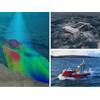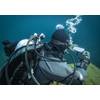Sunscreen Ingredients Might Harm Marine Life
New study finds nanosunscreens toxic to base of ocean food chain
A new study published in the American Chemical Society’s Journal of Environmental Science and Technology demonstrates the harmful effects of nanoparticles from sunscreens on ocean ecosystems. The researchers found that when nanoparticles of titanium dioxide and zinc oxide react with UV light in water, they create hydrogen peroxide, which can stunt the growth of phytoplankton. Phytoplankton are a critical species of tiny algae at the base of marine food chains, sustaining animals ranging from small fish, which feed dolphins and other sea life, to whales.
“A large percentage of sunscreens available to consumers contain nanoparticles, which means these ingredients are washed into oceans when we swim or shower,” said Ian Illuminato, Health and environment campaigner with Friends of the Earth. “These tiny ingredients are can also potentially toxic to humans and are rapidly entering food and consumer products without safety assessment or labels.”
The study indicates that these tiny particles of titanium dioxide are a major oxidizing agent entering our coastal waters, which can result in dramatic increases in hydrogen peroxide levels that damage phytoplankton crucial to marine ecosystems.
“The onslaught of pollutants in our oceans, from giant islands of plastic in the Pacific to tiny nanoparticles, cannot continue,” said John Kaltenstein, Marine policy analyst with Friends of the Earth. “We must quickly address these threats to marine life and fisheries upon which our food supply depends.”
Nanomaterials reflect a convergence of chemistry, physics and engineering at the nanoscale to take advantage of unique physical properties associated with chemicals in this small size range. Nanoparticles are measured in nanometers (nm); one nanometer is billionth of a meter. One nanometer is roughly 100,000 times smaller than the width of a human hair.
“Wearing sunscreen and protecting our skin from harmful UV rays is very important, but nano ingredients in these products may be doing more harm than good to our environment and our health,” continued Illuminato. “Despite a growing body of science calling their safety into question, our government has made little progress in protecting the public, workers and the environment from the risks posed by nanoparticles. We urgently need FDA and EPA to step up and properly regulate and label these tiny and potentially harmful ingredients.
foe.org
acs.org

















 February 2024
February 2024



